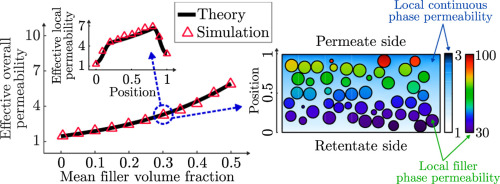当前位置:
X-MOL 学术
›
J. Membr. Sci.
›
论文详情
Our official English website, www.x-mol.net, welcomes your
feedback! (Note: you will need to create a separate account there.)
Concentration-Dependent Transport in Finite Sized Composites: Modified Effective Medium Theory
Journal of Membrane Science ( IF 8.4 ) Pub Date : 2018-03-01 , DOI: 10.1016/j.memsci.2017.12.058 Gloria M. Monsalve-Bravo , Suresh K. Bhatia
Journal of Membrane Science ( IF 8.4 ) Pub Date : 2018-03-01 , DOI: 10.1016/j.memsci.2017.12.058 Gloria M. Monsalve-Bravo , Suresh K. Bhatia

|
Abstract Current models for transport in dispersions, while grounded in well-established effective medium theory (EMT), rely on the assumption of uniformity of the driving force. As consequence, theoretical approaches cannot accommodate driving force inhomogeneities as well as variations over the space occupied by the dispersed phase particles, and existing EMT-based models therefore fail to represent finite particle size effects. Moreover, because transport coefficients are generally considered uniform, such models largely pertain to the Henry's law region. Here, using the context of permeation in mixed-matrix membranes (MMMs), we introduce a self-consistent theory for transport in dispersion-based composites, which captures effects of isotherm nonlinearity and dispersant size without introducing fitting parameters, and accurately predicts concentration-dependent permeabilities. The model is validated against rigorous 3d simulations of transport in filler-polymer composite MMMs, with excellent agreement between theoretical results and those from simulation. Both model and simulations confirm isotherm nonlinearities to have a very significant effect on effective MMM permeability, which is found to be more sensitive to isotherm nonlinearity in the filler phase than in the continuous phase. These effects disappear when the filler phase is much more permeable than the continuous phase, although additional system size effects related to exclusion regions at the ends due to finite particle size lead to decrease in permeability with increase in particle size even for linear isotherms.
中文翻译:

有限尺寸复合材料中的浓度相关输运:修正的有效介质理论
摘要 当前的分散体输运模型虽然以行之有效的有效介质理论 (EMT) 为基础,但依赖于驱动力均匀性的假设。因此,理论方法不能适应驱动力的不均匀性以及分散相颗粒占据的空间的变化,因此现有的基于 EMT 的模型无法表示有限的颗粒尺寸效应。此外,由于传输系数通常被认为是均匀的,因此此类模型主要适用于亨利定律区域。在这里,利用混合基质膜 (MMM) 中的渗透背景,我们引入了基于分散的复合材料中传输的自洽理论,该理论在不引入拟合参数的情况下捕获了等温线非线性和分散剂尺寸的影响,并准确预测浓度依赖性渗透率。该模型已针对填料-聚合物复合材料 MMM 中严格的 3d 传输模拟进行了验证,理论结果与模拟结果之间具有极佳的一致性。模型和模拟都证实等温线非线性对有效 MMM 渗透率有非常显着的影响,发现填料相中的等温线非线性比连续相中的等温线非线性更敏感。当填料相比连续相更具渗透性时,这些影响就会消失,尽管由于有限的颗粒尺寸与末端排除区域相关的额外系统尺寸效应会导致渗透率随着颗粒尺寸的增加而降低,即使对于线性等温线也是如此。该模型已针对填料-聚合物复合材料 MMM 中严格的 3d 传输模拟进行了验证,理论结果与模拟结果之间具有极佳的一致性。模型和模拟都证实等温线非线性对有效 MMM 渗透率有非常显着的影响,发现填料相中的等温线非线性比连续相中的等温线非线性更敏感。当填料相比连续相更具渗透性时,这些影响就会消失,尽管由于有限的颗粒尺寸与末端排除区域相关的额外系统尺寸效应会导致渗透率随着颗粒尺寸的增加而降低,即使对于线性等温线也是如此。该模型已针对填料-聚合物复合材料 MMM 中严格的 3d 传输模拟进行了验证,理论结果与模拟结果之间具有极佳的一致性。模型和模拟都证实等温线非线性对有效 MMM 渗透率有非常显着的影响,发现填料相中的等温线非线性比连续相中的等温线非线性更敏感。当填料相比连续相更具渗透性时,这些影响就会消失,尽管由于有限的颗粒尺寸与末端排除区域相关的额外系统尺寸效应会导致渗透率随着颗粒尺寸的增加而降低,即使对于线性等温线也是如此。模型和模拟都证实等温线非线性对有效 MMM 渗透率有非常显着的影响,发现填料相中的等温线非线性比连续相中的等温线非线性更敏感。当填料相比连续相更具渗透性时,这些影响就会消失,尽管由于有限的颗粒尺寸与末端排除区域相关的额外系统尺寸效应会导致渗透率随着颗粒尺寸的增加而降低,即使对于线性等温线也是如此。模型和模拟都证实等温线非线性对有效 MMM 渗透率有非常显着的影响,发现填料相中的等温线非线性比连续相中的等温线非线性更敏感。当填料相比连续相更具渗透性时,这些影响就会消失,尽管由于有限的颗粒尺寸与末端排除区域相关的额外系统尺寸效应会导致渗透率随着颗粒尺寸的增加而降低,即使对于线性等温线也是如此。
更新日期:2018-03-01
中文翻译:

有限尺寸复合材料中的浓度相关输运:修正的有效介质理论
摘要 当前的分散体输运模型虽然以行之有效的有效介质理论 (EMT) 为基础,但依赖于驱动力均匀性的假设。因此,理论方法不能适应驱动力的不均匀性以及分散相颗粒占据的空间的变化,因此现有的基于 EMT 的模型无法表示有限的颗粒尺寸效应。此外,由于传输系数通常被认为是均匀的,因此此类模型主要适用于亨利定律区域。在这里,利用混合基质膜 (MMM) 中的渗透背景,我们引入了基于分散的复合材料中传输的自洽理论,该理论在不引入拟合参数的情况下捕获了等温线非线性和分散剂尺寸的影响,并准确预测浓度依赖性渗透率。该模型已针对填料-聚合物复合材料 MMM 中严格的 3d 传输模拟进行了验证,理论结果与模拟结果之间具有极佳的一致性。模型和模拟都证实等温线非线性对有效 MMM 渗透率有非常显着的影响,发现填料相中的等温线非线性比连续相中的等温线非线性更敏感。当填料相比连续相更具渗透性时,这些影响就会消失,尽管由于有限的颗粒尺寸与末端排除区域相关的额外系统尺寸效应会导致渗透率随着颗粒尺寸的增加而降低,即使对于线性等温线也是如此。该模型已针对填料-聚合物复合材料 MMM 中严格的 3d 传输模拟进行了验证,理论结果与模拟结果之间具有极佳的一致性。模型和模拟都证实等温线非线性对有效 MMM 渗透率有非常显着的影响,发现填料相中的等温线非线性比连续相中的等温线非线性更敏感。当填料相比连续相更具渗透性时,这些影响就会消失,尽管由于有限的颗粒尺寸与末端排除区域相关的额外系统尺寸效应会导致渗透率随着颗粒尺寸的增加而降低,即使对于线性等温线也是如此。该模型已针对填料-聚合物复合材料 MMM 中严格的 3d 传输模拟进行了验证,理论结果与模拟结果之间具有极佳的一致性。模型和模拟都证实等温线非线性对有效 MMM 渗透率有非常显着的影响,发现填料相中的等温线非线性比连续相中的等温线非线性更敏感。当填料相比连续相更具渗透性时,这些影响就会消失,尽管由于有限的颗粒尺寸与末端排除区域相关的额外系统尺寸效应会导致渗透率随着颗粒尺寸的增加而降低,即使对于线性等温线也是如此。模型和模拟都证实等温线非线性对有效 MMM 渗透率有非常显着的影响,发现填料相中的等温线非线性比连续相中的等温线非线性更敏感。当填料相比连续相更具渗透性时,这些影响就会消失,尽管由于有限的颗粒尺寸与末端排除区域相关的额外系统尺寸效应会导致渗透率随着颗粒尺寸的增加而降低,即使对于线性等温线也是如此。模型和模拟都证实等温线非线性对有效 MMM 渗透率有非常显着的影响,发现填料相中的等温线非线性比连续相中的等温线非线性更敏感。当填料相比连续相更具渗透性时,这些影响就会消失,尽管由于有限的颗粒尺寸与末端排除区域相关的额外系统尺寸效应会导致渗透率随着颗粒尺寸的增加而降低,即使对于线性等温线也是如此。











































 京公网安备 11010802027423号
京公网安备 11010802027423号